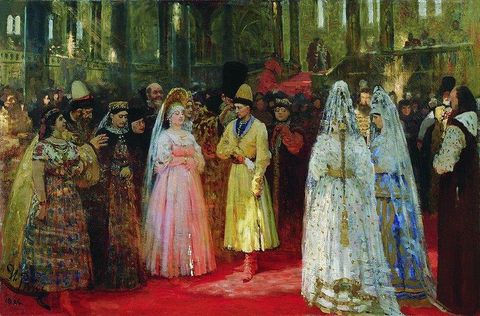“Of course I have used dissonance in my time, but there has been too much dissonance. Bach used dissonance as good
salt for his music. Others applied pepper, seasoned the dishes more and more highly, till all healthy appetites were sick
and until the music was nothing but pepper.”
AUTHOR: Sergei Prokofiev
MEANING OF THE QUOTE:
"Dissonance in music (different sounds that do not blend pleasantly together) should
AUTHOR: Sergei Prokofiev
MEANING OF THE QUOTE:
"Dissonance in music (different sounds that do not blend pleasantly together) should
be used like spices are used in food; overuse will spoil the product."
Grigor loves Martha, fiancée of the aristocrat Lykov. Grigor asks a magician for a love potion; but the magician, compelled by Grigor's former lover Liubacha, substitutes a slow but effective poison, which Grigor unwittingly gives Martha. Then, the Tsar announces that he will take Martha as his bride. She becomes Tsarina, but dies mysteriously. When Liubacha confesses, Grigor kills her, and he is arrested. http://www.jhu.edu/jhso/about/prgrmnotes/pn_19891029.html
Ivan the Terrible Choosing His Bride
Lois Rowell Karlsberger
Overture to The Tsar's Bride
Nicolai Rimsky-Korsakov
The overture from Rimsky-Korsakov's 1898 opera, The Tsar's Bride, attests to his orchestral virtuosity and his affinity for dramatic subjects rooted in Russian history and folklore. A member of ``The Mighty Five'' of Russian nationalistic music, he was inspired by Glinka's opera, A Life for the Tsar (1836). Characteristically, Rimsky-Korsakov's operas display a wealth of color and lyricism, an extensive use of folk melodies, and a mastery of orchestral effects. Many of his operas move in a fantasy world of romance and legend. The Tsar's Bride, however, is a tragedy, set during the reign of Ivan the Terrible.
Ivan the Terrible by Viktor Vasnetsov
This painting by Ilya Yefimovich Repin, executed between 1884 and 1887,
depicts Russian Tsar Michael I choosing his bride from an array of fair maidens in 1626.




